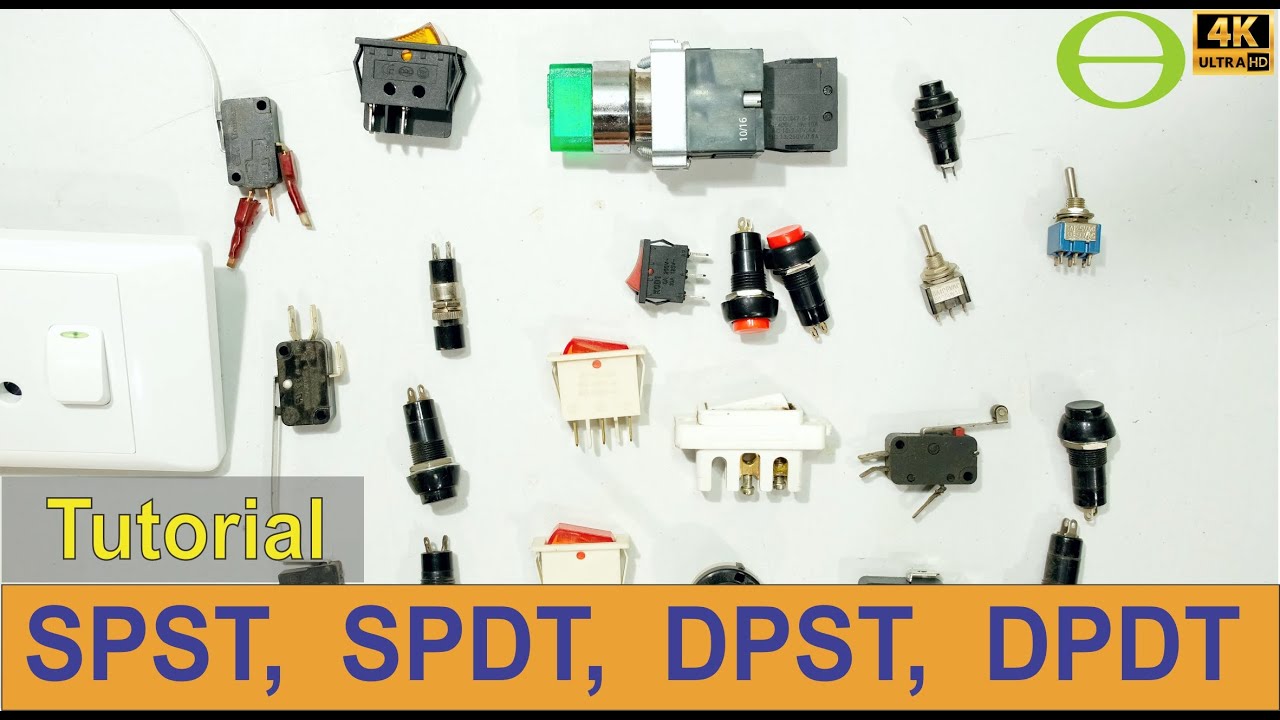Choosing the Right Switch
I. Understanding Switch Types
Firstly, it’s essential to clarify the type of switch needed, such as Single Pole Single Throw (SPST), Single Pole Double Throw (SPDT), or Double Pole Double Throw (DPDT). Different switch types cater to various circuit control requirements.
II. Determining Ratings and Load Types
- Ratings: The rated current and voltage of a switch are crucial parameters. Ensure the selected switch’s ratings can meet the circuit’s current and voltage demands, preventing damage or safety hazards due to overloads.
- Load Types: Different load types (e.g., inductive loads, motor loads) can produce varying current surges during switching. Hence, consider the load type to match the appropriate switch.
III. Selecting Quality Materials and Craftsmanship
- Housing Material: High-quality switches often use flame-retardant PC material for their housing, which is flame-retardant, impact-resistant, and resistant to discoloration. Avoid switches made from poorer materials like mixed plastics or ABS.
- Internal Wiring Terminals: The wiring method of the terminals affects electrical safety. While the clamp wiring method is safest but costlier, the double-hole pressure plate structure is generally sufficient. Ensure the wires are tightly secured to reduce resistance and enhance safety.
- Contact Materials: Contacts are the touching points of conductive parts during switching, and their size and material are crucial. High-quality switch contacts are made of pure silver or silver alloys, offering excellent conductivity and wear resistance.
IV. Considering the Usage Environment and Appearance
- Usage Environment: Choose a suitable waterproof or specially protected switch based on the environmental conditions (e.g., humidity, dust).
- Appearance: The switch’s appearance should complement the overall indoor style. Look for switches with a smooth, burr-free, and sleek finish.
What is a SPST?
A Single Pole Single Throw (SPST) switch is a basic type of switch used in electrical circuits. It has one input (pole) and one output (throw), allowing it to connect or disconnect a single wire within a circuit. When the switch is in the “on” position, it completes the circuit, allowing current to flow through. When in the “off” position, it breaks the circuit, stopping the current flow. SPST switches are commonly used in simple on-off applications like light switches, where you need to control a single device. They are easy to operate and are fundamental components in various electronic devices.
.jpg)

What is a SPDT?
A Single Pole Double Throw (SPDT) switch is an electrical switch with one input (pole) and two possible outputs (throws). It can connect the input to either of the two outputs, allowing it to control two different circuits. SPDT switches are commonly used in applications where there is a need to switch between two different states or paths, such as in selecting between two power sources or routing signals in electronic devices. They have three terminals: one common terminal (COM), one normally closed terminal (NC), and one normally open terminal (NO). When the switch is activated, the connection between COM and NC is broken, and a connection is made between COM and NO.
What is a DPST?
A DPST, or Double Pole Single Throw switch, is an electrical switch with four terminals: two input and two output. It can control two separate circuits simultaneously with a single toggle. When the switch is in the “on” position, both circuits are connected, allowing current to flow through both. When in the “off” position, both circuits are disconnected. DPST switches are often used in applications where it is necessary to disconnect or connect two independent circuits at the same time, such as in controlling both the live and neutral connections in an electrical appliance.


What is a DPDT?
A DPDT (Double Pole Double Throw) switch is an electrical component with two input circuits (poles) and two output positions (throws) for each pole. It can connect each input to one of two outputs, allowing it to control two separate circuits simultaneously. DPDT switches are often used to reverse the polarity of a circuit, such as in motor control applications where changing the direction of current flow is necessary. They have six terminals: two for the input connections and four for the output connections. By toggling the switch, you can change the paths through which electricity flows, enabling versatile control over complex circuits.
SPST SPDT and DPST DPDT
Single pole single throw
Single pole double throw
Double pole single throw
Double pole double throw
SPST VS SPDT
SPST (Single Pole Single Throw) and SPDT (Single Pole Double Throw) are types of electrical switches.
SPST:
- Function: Acts as an on-off switch.
- Configuration: Has one input and one output.
- Use: Simple switching applications like turning a light on or off.
SPDT:
- Function: Switches between two outputs.
- Configuration: Has one input and two outputs.
- Use: Allows selecting between two different circuits, like switching between two power sources.
Simplified:
- SPST: One path, on/off.
- SPDT: One input, switchable between two outputs.
SPST VS DPST
SPST (Single Pole Single Throw) and DPST (Double Pole Single Throw) are types of switches used in electrical circuits.
SPST
- Single Pole: Controls one circuit.
- Single Throw: Has two positions, open (off) and closed (on).
- Function: Simple on/off switch, like a light switch.
DPST
- Double Pole: Controls two separate circuits simultaneously.
- Single Throw: Each pole has two positions, both open or both closed.
- Function: Used to control two circuits either together or separately, like turning off both the live and neutral wires in a circuit.
Both are used to control the flow of electricity, but DPST can manage two circuits at once, providing more versatility.
Common Mechanical Switches
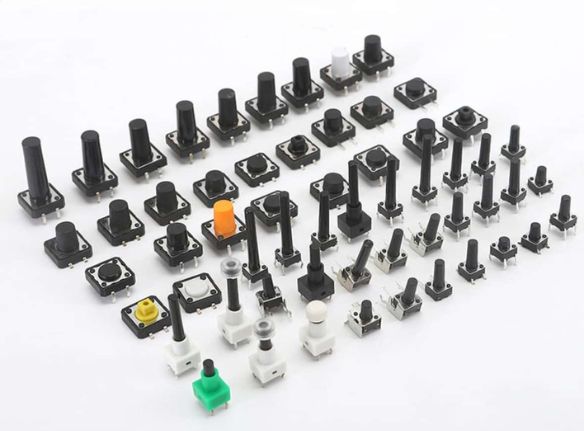
Tactile switches are small, mechanical switches commonly used in keyboards, game controllers, and other electronics. They provide a tactile response, meaning users feel a physical “click” when the switch is pressed. This feedback helps confirm the action has been registered. They come in various sizes and force ratings, allowing customization for different applications and user preferences.
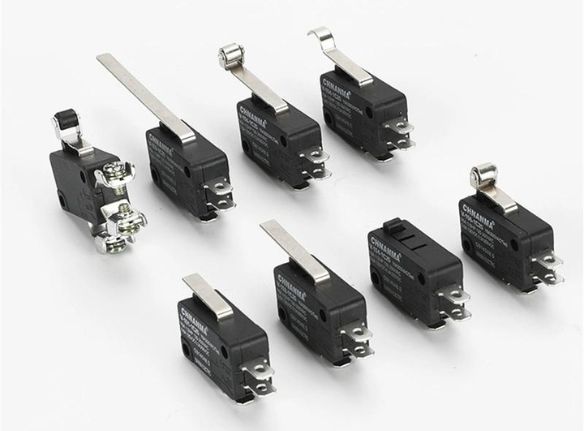
A micro switch is a small, quick-acting electrical switch used in various devices for precise and reliable control. It operates with minimal physical force and features a spring-loaded lever or button that triggers the switch when pressed. Common applications include appliances, machinery, and automotive systems, where they detect changes in position or actuate mechanical movements.
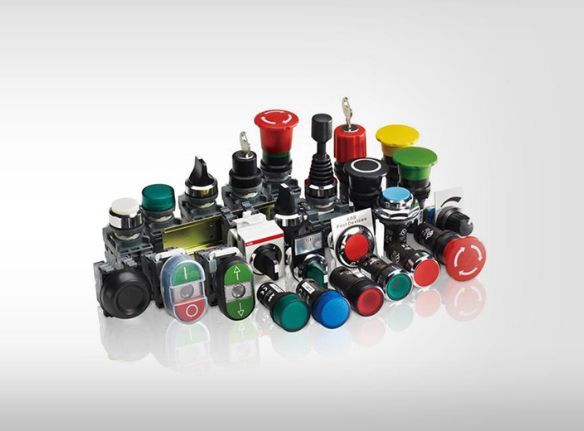
A push button switch is a simple switch mechanism for controlling an electrical circuit. It consists of a button that, when pressed, either makes or breaks the connection. This action allows current to flow or stops it, enabling control of devices and systems. Commonly found in household appliances, industrial equipment, and electronic devices, it offers a user-friendly interface for turning devices on or off.
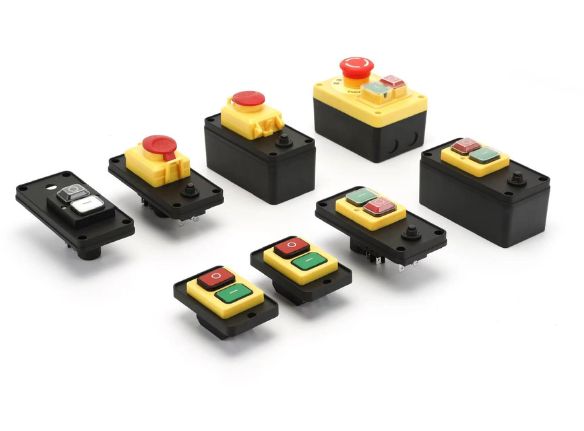
A power tools switch is a component used to turn power tools on and off. It typically consists of a button or lever that controls the flow of electricity to the tool’s motor. When the switch is engaged, it completes the electrical circuit, allowing the tool to operate. Releasing or turning off the switch breaks the circuit, stopping the tool. It ensures user control and safety during operation.
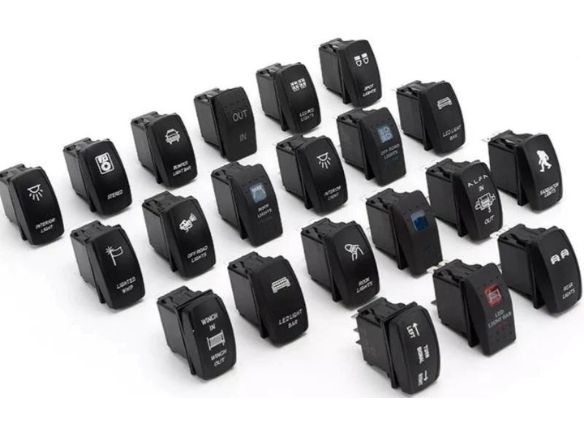
Marine rocker switches are durable, waterproof switches designed for use on boats and other marine equipment. They feature a rocking mechanism that toggles between “on” and “off” positions. These switches are made to withstand harsh marine environments, including exposure to water, salt, and UV rays, ensuring reliable electrical control for lights, pumps, and other onboard systems.
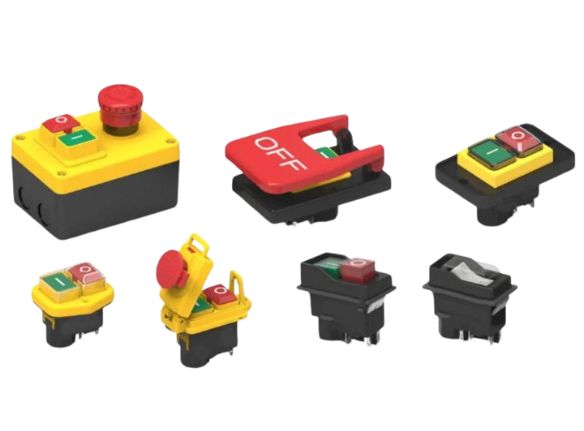
Electromagnetic switches, or relays, use an electromagnet to control the opening and closing of electrical circuits. When current flows through the electromagnet, it generates a magnetic field that moves a lever, opening or closing the switch. They’re commonly used for switching high-power devices with low-power signals, providing isolation between control and load circuits.
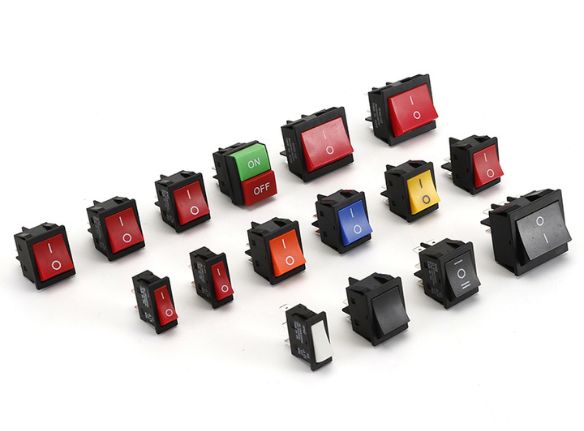
A rocker switch is an electrical switch that rocks back and forth to open or close a circuit. It typically has a rectangular or oval shape and is often used in household appliances, power strips, and other electronic devices. When one side is pressed, it completes the circuit, and pressing the other side breaks the circuit. Rocker switches can be single-pole, double-pole, illuminated, or non-illuminated.




